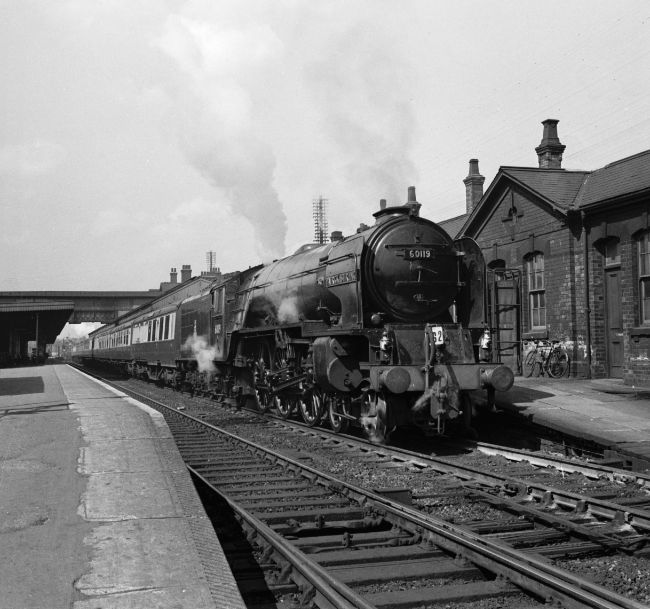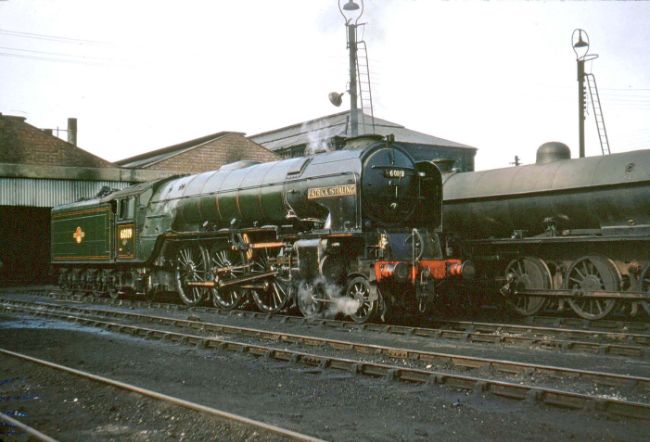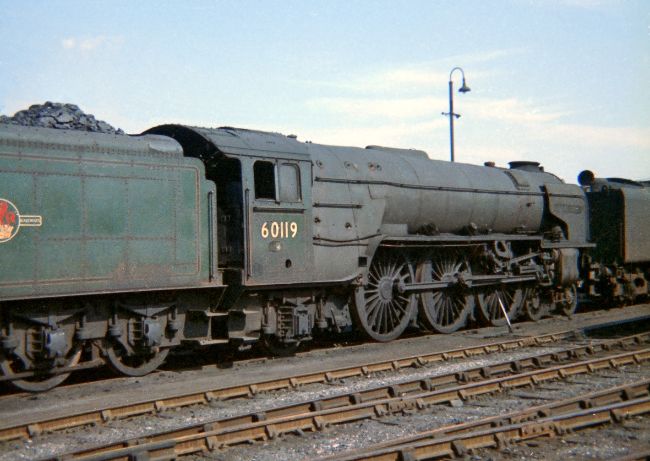Emerging from Doncaster Works along with No. 60118 in November 1948 (Works No. 2036), the sixth A1 was resplendent in the customary apple green LNER livery with black and white lining plus the words ‘BRITISH RAILWAYS’ on the tender, although the plain chimney was perhaps not as elegant as the rest of the locomotive. One of five A1s to be allocated initially to Cropley Hill, it entered service on the 26th. The first recorded working was passing Doncaster on 21st December with the 09:50hrs Leeds to King’s Cross passenger train. No. 60119’s travels included the south and middle sections of the East Coast Main Line; on 1st June it was noted at Darlington while on the following Christmas Eve it was derailed at King’s Cross when backing onto the down ‘Queen of Scots’. Although the sixth A1 it was further down the queue to go into the new BR express blue livery with black and white lining and the early lion and wheel emblem on the tender; when dealt with in June 1950 it was one of four to be repainted that month although a further 16 had previously appeared in the new colours. About this time the Hudd ATC system was fitted but the Flaman speed recorder was removed. Naming took place in July, one of four that month although 16 A1s had already been named before then. Like its numerical predecessor, No. 60119 was named to commemorate an eminent GNR locomotive superintendent whose tenure was three decades (1866 to 1895). The name Patrick Stirling was an appropriate choice for that engineer was best remembered for his ‘Singles’ – the epitome of nineteenth century elegance combined with power; in the A1s we have a twentieth century version of those same qualities.

An undated study taken at Grantham of No. 60119 in blue – Bill Reed
Most of Patrick Stirling’s early life was spent between west Yorkshire and London. Named trains hauled included the up ‘Yorkshire Pullman’ followed by the down 15:45hrs ‘West Riding’ on 5th July 1952. An ordinary working recorded was leaving Doncaster at 15:03hrs on 2nd July 1953 with a King’s Cross to Leeds train. A repaint into the dark green livery with orange and black lining came in February 1952; nearly half the class had been repainted by then. The plain chimney was replaced by the more attractive lipped version.

No. 60119 at Ganwick with the up ‘Yorkshire Pullman’ 5th July ’52 – John P. Wilson / RAS
Reallocation to Grantham occurred on 18th December 1955. Workings featured trains both down the main line and into Yorkshire. Four times between New Year’s Eve 1955 and 7th January 1956 No. 60119 departed Newcastle at 12:55hrs with a Glasgow to King’s Cross train; the same working is recorded in subsequent months. On 30th March 1956 Patrick Stirling arrived at Newcastle for the Tyne Commission Quay at 14:49hrs with a boat train from the capital and returned from Newcastle with the up ‘Heart of Midlothian’. The 22:20hrs from the ‘Cross to Edinburgh and the 10:20hrs train to Leeds were each noted a number of times in the last four months of 1956. A more local working was the 06:45hrs to Grantham from the capital on 29th December. The 15:10hrs to Newcastle was noted seven times in the first 17 days of 1957 while on 20th April No. 60119 hauled the down ‘Flying Scotsman’ into Newcastle. In common with the other A1s, the smokebox numberplate and handrail were transposed and the later BR crest applied to the tender in August 1957.
A transfer to King’s Cross took place in September. Observations made concern the east coast route; the down ‘Flying Scotsman’ hauled into Newcastle on 21st September and the up train from Newcastle but the locomotive was recorded as failing at Durham on 4th June 1958. Photos from this period show an AWS plate fitted to the front bogie and a protector plate below the bufferbeam.
Yet another transfer for this increasingly nomadic Pacific was to Doncaster on 3rd August. Observations are mainly between that town and the capital although it was noted on 14th June 1959 with 13 coaches on a Leeds to King’s Cross train. As the 1960s unfolded non-passenger work was increasingly seen. Examples include passing Peterborough on 20th August 1960 with 11 vehicles on the up mail. Goods featured with a down freight at Grantham on 21st April 1962 and the 3E22 Aberdeen to King’s Cross fish hauled from Newcastle on 2nd January 1963 as a return working to the 1A12 boat train from the capital for Tyne Commission Quay. Rosters were truly a mix of passenger and non-passenger workings. Named trains included the ‘Queen of Scots’ from the ‘Cross on 8th January and arriving with the up ‘Master Cutler’ 13 days later. Other trains noted in June were the 18:12hrs departures to Leeds. Of note is that No. 60119 was stand-by engine at Doncaster on 13th January and station pilot there on 14th June.

An undated colour image taken at Doncaster – Bill Reed
The final trains recorded were the 3S46 York to Edinburgh parcels arriving in Newcastle on 21st December 1963 and the 10:00hrs York to Edinburgh on 18th January in 1964 with the locomotive failed at Darlington. Throughout its life spent largely on the southern and central sections of the main line Patrick Stirling had carried seven boilers. Withdrawal came on 31st May 1964 with disposal to Cox & Danks, Wadsley Bridge in August for scrap.

No. 60119 is seen at Doncaster Carr Loco in 1964 - Dick Manton
This history was compiled by Phil Champion based on a database compiled by Tommy Knox and with reference to the RCTS book “Locomotives of the LNER Part 2A” as background. Revised and updated by Graham Langer, May 2020.